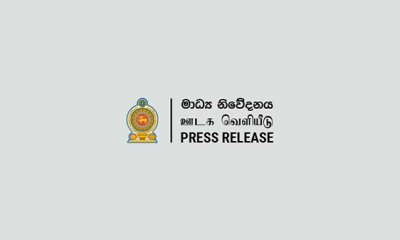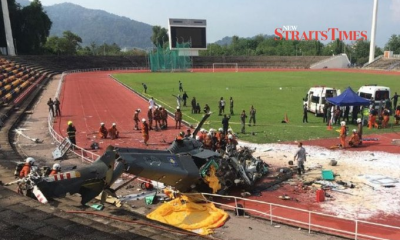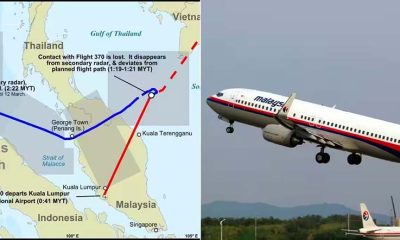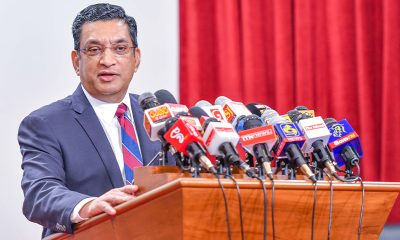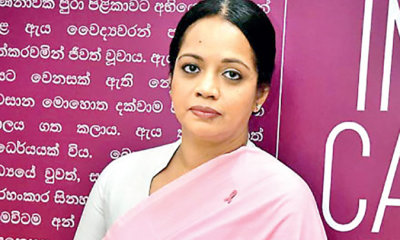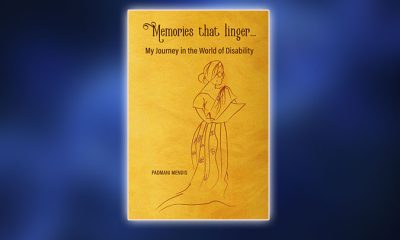Features
Friends I made along the way, meeting in Colombo and on to Malaysia
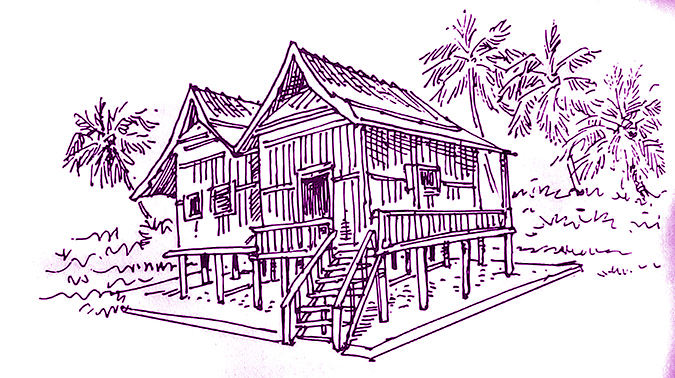
(Excerpted from Memories that linger: My Journey in the World of Disability by Padmani Mendis)
Barbara McNamee was from Jamaica. She became my friend when we met in the month of October in 1958 as student nurses at the Royal Orthopaedic Hospital (ROH) in Birmingham, England. I have shared memories of our time together then in an earlier part of this memoir. We had been together for five years and three months. Mahin and Lyda both from Iran, then Persia were also with us.
The four of us became good friends during our first few days at the ROH. And we have remained close friends since then. In those first months, two calypso songs were particularly popular in the UK. They had just been released by the singer Harry Belafonte and were both about Jamaica. I enjoyed singing these to Barbara, especially when I saw that she was feeling a little low. One, “Island In The Sun” I mentioned a little earlier in this section. You may have heard the other “Jamaican Farewell”. They are available on YouTube. I occasionally send these to Barbara on WhatsApp just to remind her of the old days.
Barbara met Mike Rogers while she was at the ROH and he was a post-grad student at the University of Birmingham. They married soon after we completed our physiotherapy education. They had two children and spent the larger part of their lives in England.
Mahin left Iran much later to live in the USA and is now in Canada. She first had an Iranian husband and then an Egyptian one. Three stepsons living also in Toronto look out for her. Lyda also married an Englishman, Lewin Harris, and settled down in England. She passed on a few years ago. Barbara, Mahin and I still communicate regularly.
We last met five years ago. Mahin and I spent two weeks with Barbara in her home in Surrey, just outside London. Spent most of the time reminiscing with Barbara driving us around the picturesque Surrey countryside. Together with memorable meals in several old English Pubs. Much to the amusement of the other two, I always went for the Fish and Chips.
Following up in St. Lucia
There was every reason to believe that within this brief period CBR (Community Based Rehabilitation) had been well-established in St. Lucia. The country had plans to expand this programme.
One was able to reach the conclusion that the Manual had been an effective tool used by disabled people, their families and the Community Health Assistants. CHAs with a basic training of three months for their Primary Health Care work could with a further training of at least 12 days in a workshop situation and a further three weeks of field training and with regular and adequate support from a higher level carry out their rehabilitation tasks with disabled people successfully. The availability of second level support enhanced quality and coverage.
The Community Health Nursing Service or CHNS, recognising the value of the inputs from the two physiotherapists from the Victoria Hospital, intended to request the Ministry of Health for one of these therapists to be released to the CHNS. The CHNS was continuing its dialogue with the education sector to promote the inclusion of disabled children in local schools. They had started a conversation with employers regarding job opportunities for disabled youth and adults. And an information campaign to increase public participation in what was now a programme and no more a project.
I left St. Lucia confident that disabled people here had hope for the future.
Marcella Niles
But I cannot leave St. Lucia before including Marcella Niles in my story. The Community Health Nursing Service was her responsibility. As my counterpart she went everywhere with me. In Castries she drove me around herself in her own car. To go out of Castries we had access to a larger vehicle from the CHNS but often driven by Miss Niles herself. Marcella Niles was very proud of her island and quite rightly so.
She guided me to the most beautiful parts of St. Lucia. She would, whenever she could, take me through the town of Soufriere so that I could see the Pitons. And she always pointed them out to me – Big Piton and Small Piton, two tall volcanic spurs rising straight up from the sea, adjoining the coast. They were linked by some sort of a ridge.
On a few occasions when we had time to spare, she took me to see tropical rain forests which St. Lucia is well-known for. We in Sri Lanka have our own famous rain forest Sinharaja, which is a World Heritage Site. But these in St. Lucia were somehow different. Maybe had I gone deeper into our Sinharaja I would have found a similarity. In addition to the giant ferns and lush greenery, it was very, very wet all the time – as if a very slight rain was constantly falling. It was surprising that one could also see scrub forests in some parts of this small island.
For my stay in St. Lucia Marcella had found me accommodation in an Apartment Hotel, quite common in the Caribbean. This suited me well. It had a pool which none of the other residents appeared to use. So I had it to myself every evening after work.
After relaxing in the water, I would walk to the little shop at the bend in the road, not far down from me. There I would find something to cook for myself to eat with rice for the evening meal. May be some mixed vegetables or some fish. Whatever it was, it was tasty, cooked with St. Lucian curry powder. And always a luscious mango to follow. However good that mango was, it could not touch our delicious Jaffna mangoes for taste.
A Meeting in Sri Lanka
Before I move on from this phase of my journey in South America and the Caribbean, there was a meeting I must stop for. It was one I was called upon to organise – the WHO Interregional Consultation on CBR held in Colombo in June 1982.
WHO Interregional Consultation on CBR, 1982
It was almost three years since we had started work in the field. We felt the time was ripe to get the people who have been testing the Manual together to share experiences. Einar suggested that I organise the meeting in Colombo. Sri Lanka had also been participating in the field trial.
I was extremely fortunate and overjoyed to welcome to my own country so many friends I had made on my travels to their countries. Dr. Hindley-Smith asked for my help to organise a tour to places of historical interest and to the game parks. Others toured independently after the meeting was over. My country was, after all, a tourist attraction. And although I say it myself – it is beautiful.
When I had been in Jamaica, it had reminded me much of my own country. So much so that I had this in my thoughts. If ever, if ever I had to leave my motherland for some reason or another, I would settle down in Jamaica. That too was beautiful, particularly the northwest where I was, away from the tourist hot spot of Montego Bay. Not just the beaches and scenery, but more importantly, its people.
During our meeting Einar and Gunnel were guests in our home. This was not just enjoyable but also useful to have more time to spend in discussion and planning the next steps. For our meeting, 22 participants came together from all parts of the globe. Countries that had carried out field tests were Botswana, Burma, India (Kerala State), Mexico, Nigeria, Pakistan, Philippines, St. Lucia and Sri Lanka. There were also others who were invited as representatives of WHO, other UN organisations and NGOs and some as individuals.
After an exchange of experiences from these countries, they spent much time giving their suggestions in detail as to what revisions should be made in the WHO Manual. These were taken into account when the Manual was revised the following year. CBR had been born.
Back to Asia – Malaysia
My First Contact with Malaysia
The first time I went to Malaysia was in 1983 to represent WHO at the Seventh Asia & Pacific Conference of Rehabilitation International, known globally as RI. It was founded in 1922 as an organisation that led discussion on issues related to disability at a global level. The climax of its work was a World Congress held every four years. On my stopover in Mexico, I referred to Dr. Hindley-Smith telling me about his participation at the RI Congress in Ireland in 1969. It brought about the realisation in him of the extent of neglect of disabled people in developing countries.
At that Congress, RI was promoting new thinking on personnel required for rehabilitation. It was looking at disability as a charity-based concept. In the 1980s it was promoting interventions for people with disability to improve their quality of life in a social context. Then, early in this millennium when the UN Convention on the Rights of Persons with Disabilities had been approved, their interest evolved to the promotion of disability rights.
Correspondingly, CBR had been accepted by the World Health Assembly. Increasingly now, more countries were adopting this approach both for policy and implementation. My own CBR story is about the small part I played travelling from country to country assisting them to start putting policy into practice. Just planting a seed as it were. How that seed would germinate and into what kind of tree it would grow was left to be seen. But germinate it did and by the time I got to Malaysia I was amazed at the way CBR was maturing.
It was blending with the particular ethos of each country to meet the needs of its disabled people.Seventh Asia & Pacific Conference of Rehabilitation International, Kuala Lumpur, 1983 RI (Rehabilitation International), the world body had some regional branches. Every two years RI organised a meeting in one of its regions. This first one I was invited to was in the Asia Pacific Region.
I was a speaker at a Plenary Session on the second day of the conference. The speaker before me was Dr. Siti Hasmah binti Haji Mohamad Ali, wife of the Prime Minister of Malaysia who we know as Mahathir Mohamed.
The topic of her presentation was a rather general one, focusing on the family as a vital provider of care. I had an opportunity of speaking with her in the break that followed the panel discussions. She told me her particular interest at that time was improvement in the situation of rural women.
That is why she had agreed to participate at this conference. She felt the discussion we had would help to promote her cause. I learned later that she and her husband had met at Medical School. They had been married soon after they left university.
I had been invited to present a paper on “CBR as a Relevant Approach for Developing Countries’. I included in the paper my thoughts on why a new approach was necessary with data from Sri Lanka. I also included a précis of the approach with examples, that WHO had adopted assisting countries to develop and of how it had impacted the quality of life of individuals and families; and a few results with statistical data from three countries – Botswana, Mexico and Sri Lanka, in three continents; and mention of its relationship to Primary Health Care, which at that time provided an entry point with the infrastructure.
My conclusions were that, “The results to date indicate emphatically that the approach is suited to the needs of developing countries… The quality of results cannot be questioned – for where better to provide freedom of mobility, create independence in daily life activities and enable disabled people to participate in the mainstream of community life than in the environment of their own communities?”
“The integration of disabled children in existing local schools and the provision of income generating opportunities within their own communities has ensured for disabled people full participation with true integration, starting with the family. It has done away with the need for them to be transported to a new and strange environment to be rehabilitated”.
Is CBR a Medical Model?
These results above are those that critics argued made CBR a “Medical Model” propagated by WHO. Some said this was because CBR was concerned also with functional independence. I say that maximal functional independence is an indication of an individual’s health status, beyond a medical condition. Improvement in the health of an individual is a human right. Besides, even an individual’s functional independence is not possible without social change in the community the individual lives in.
My own finding and therefore my argument was that participation in community life be it educational, functional or economic, cannot happen without a change in community attitudes. And with that an acceptance of disabled people on the basis of equality. An approach that was at this time being called “the Social Model”. CBR, based on the responsibility of the community, brought about a social change.
But I also saw CBR go beyond a purely social foundation; it also extended to enabling disabled people enjoy the same opportunities and responsibilities as others in their communities, an approach that is now called “the Human Rights Model”.
The world of disability did not use the words “human rights” at that time. But this was CBR’s needs-based approach, enabling equality in all matters including human rights. What is important is that CBR was not, for instance an individual-based, service-based approach reaching out from centres in districts or elsewhere. In these instances, responsibility lay with those centres, not with the communities in which disabled people lived.
Introducing CBR to Malaysia
It was against this background that the Government of Malaysia requested WHO cooperation to initiate CBR. In response, WHO sent me there for three months from February to May 1994. The mandate for matters related to disability lay with the Ministry of Social Welfare.
Initial discussions were with the Secretary of this Ministry. We talked about what he expected from me and about how I would set about the task he had set me. I said that WHO’s advice to countries was that the Manual, “Training in the Community for People with Disabilities”, be used as a tool for empowering disabled people and families with the knowledge and skills they required to start any change. I said without this tool for empowerment translated into Bahasa Malaysia CBR would be difficult for me to initiate in three months.
The Secretary called together ten members of his senior office staff. He removed the cord that held the different modules of the Manual together and separated the modules into ten lots. Giving one lot to each of his staff he said, “Could you please translate these and let me have them back by Monday?” Typed and photocopied, a sufficient number of Manuals were available to us when we required them. Such was the dynamism of this man who led the Ministry of Social Welfare at that time. I thought to myself, with this leadership anything should be possible.
So far, in other countries I had introduced CBR at the grass roots, promoting the development of a system upwards to support it. The structure for CBR was as yet incomplete in those countries, because appropriate mid-level personnel were lacking. This was a serious constraint for ensuring effectiveness as well as for sustainability.
Here in Malaysia for the first time, I was introducing CBR within a support system which had responsibility for disability – the Social Welfare Ministry. The Ministry had Social Welfare Assistants or SWAs at district level. To support them were Social Welfare Officers or SWOs at state level. Among them would be mid-level workers. They required relevant knowledge and skills in CBR. They required also to have this task included in their job descriptions. Then the focal points for a CBR system would be in place at the two support levels.
It would be up to officials at these levels to build the horizontal linkages within and outside government at each level that would together provide communities with the support they required. In development jargon this was called multi-sectoral collaboration. In reality, it sometimes worked in bits and pieces, often it did not. Much work was required here globally.
Local Accommodation
During the three months that I spent in Malaysia I was to work in Batu Rakit in the State of Terengganu on the east coast. Batu Rakit was a “Mukim” or sub district just over a half-hour drive from Kuala Terengganu, the capital of the state.
Our teaching area was rural. It was a quiet fishing village with the appearance of serenity and tranquillity. I was fortunate to be given accommodation here in a kind of rest house run by the state. This was a simple building set in a large property scattered with very tall coconut trees. There were a few rooms and some common bathrooms and toilets. The female participants from other states were accommodated in this rest house with me. Other participants found lodging in homes in the area. Evening meals to all were provided at the rest house. Because of this the group found much time to get to know each other and to talk about areas of common interest including work.
I liked very much the local food that was served. It was simple. “Nasi” means rice which is the staple in every meal. Here it was white rice served with Malaysian “curry”. Curries were in no way like ours, but this is what the dishes were called in English.
They were cooked with what we may call a raw curry powder – turmeric, coriander, cumin, cardamom, cloves, cinnamon and ginger, with such condiments added in different proportions. As a result of these particular condiments, the taste was subtle quite unlike ours which tends to be spicy, even our white curries.
The rice was served with many different vegetables, and always fish from the village. My favourite Malaysian dish was nasi dagang. For special Malaysian dishes such as these, the rice is cooked in coconut milk, and it turns out rather like our milk rice or “kiributh”. Except that it is flavoured with pandan leaf or “rampe”.
The tastiest nasi dagang I had was served in the Hotel in Kuala Terengganu where I stayed for a few days before moving to Batu Rakit. It was served with fried sprats, shrimp sambol, a boiled egg and cucumber. What we eat as nasi lemak in Colombo or even the food in Kuala Lumpur is nothing like the Malaysian food I ate in Kuala Terengganu. There, food was very tasty with the subtle flavours of the food itself.
In Colombo I now eat Malaysian food with a rather spicy chicken curry, adapted to suit the local palate. In all my later visits to Kuala Lumpur staying in international hotels as I did, I was not able to find the original Malaysian food that I had enjoyed in the rest house in Batu Rakit.
Features
The Venezuela Model:The new ugly and dangerous world order

 The US armed forces invading Venezuela, removing its President Nicolás Maduro from power and abducting him and his wife Cilia Flores on 3 January 2026, flying them to New York and producing Maduro in a New York kangaroo court is now stale news, but a fact. What is a far more potent fact is the pan-global impotent response to this aggression except in Latin America, China, Russia and a few others.
The US armed forces invading Venezuela, removing its President Nicolás Maduro from power and abducting him and his wife Cilia Flores on 3 January 2026, flying them to New York and producing Maduro in a New York kangaroo court is now stale news, but a fact. What is a far more potent fact is the pan-global impotent response to this aggression except in Latin America, China, Russia and a few others.
Colombian President Gustavo Petro described the attack as an “assault on the sovereignty” of Latin America, thereby portraying the aggression as an assault on the whole of Latin America. Brazilian President Luiz Inácio Lula da Silva referred to the attack as crossing “an unacceptable line” that set an “extremely dangerous precedent.” Again, one can see his concern goes beyond Venezuela. For Mexican President Claudia Sheinbaum the attack was in “clear violation” of the UN Charter, which again is a fact. But when it comes to powerful countries, the UN Charter has been increasingly rendered irrelevant over decades, and by extension, the UN itself. For the French Foreign Minister, the operation went against the “principle of non-use of force that underpins international law” and that lasting political solutions cannot be “imposed by the outside.” UN Secretary General António Guterres said he was “deeply alarmed” about the “dangerous precedent” the United States has set where rules of international law were not being respected. Russia, notwithstanding its bloody and costly entanglement in Ukraine, and China have also issued strong statements.
Comparatively however, many other countries, many of whom are long term US allies who have been vocal against the Russian aggression in Ukraine have been far more sedate in their reaction. Compared to his Foreign Minister, French President Emmanuel Macron said the Venezuelan people could “only rejoice” at the ousting of Maduro while the German Chancellor Friedrich Merz believed Maduro had “led his country into ruin” and that the U.S. intervention required “careful consideration.” The British and EU statements have been equally lukewarm. India’s and Sri Lanka’s statements do not even mention the US while Sri Lanka’s main coalition partner the JVP has issued a strongly worded statement.
Taken together, what is lacking in most of these views, barring a negligible few, especially from the so-called powerful countries, is the moral indignation or outrage on a broad scale that used to be the case in similar circumstances earlier. It appears that a new ugly and dangerous world order has finally arrived, footprints of which have been visible for some time.
It is not that the US has not invaded sovereign countries and affected regime change or facilitated such change for political or economic reasons earlier. This has been attempted in Cuba without success since the 1950s but with success in Chile in 1973 under the auspices of Augusto Pinochet that toppled the legitimate government of president Salvador Allende and established a long-lasting dictatorship friendly towards the US; the invasion of Panama and the ouster and capture of President Manuel Noriega in 1989 and the 2003 invasion of Iraq both of which were conducted under the presidency of George Bush.
These are merely a handful of cross border criminal activities against other countries focused on regime change that the US has been involved in since its establishment which also includes the ouster of President of Guyana Cheddi Jagan in 1964, the US invasion of the Dominican Republic in 1965 stop the return of President Juan Bosch to prevent a ‘communist resurgence’; the 1983 US invasion of Grenada after the overthrow and killing of Prime Minister Maurice Bishop purportedly to ensure that the island would not become a ‘Soviet-Cuban’ colony. A more recent adventure was the 2004 removal and kidnapping of the Haitian President Jean-Bertrand Aristide, which also had French support.
There is however a difference between all the earlier examples of US aggression and the Venezuelan operation. The earlier operations where the real reasons may have varied from political considerations based on ideological divergence to crude economics, were all couched in the rhetoric of democracy. That is, they were undertaken in the guise of ushering democratic changes in those countries, the region or the world irrespective of the long-term death and destruction which followed in some locations. But in Venezuela under President Donald Trump, it is all about controlling natural resources in that country to satisfy US commercial interests.
The US President is already on record for saying the US will “run” Venezuela until a “safe transition” is concluded and US oil companies will “go in, spend billions of dollars, fix the badly broken infrastructure, the oil infrastructure, and start making money” – ostensibly for the US and those in Venezuela who will tag the US line. Trump is also on record saying that the main aim of the operation was to regain U.S. oil rights, which according to him were “stolen” when Venezuela nationalized the industry. The nationalization was obviously to ensure that the funds from the industry remained in the country even though in later times this did lead to massive internal corruption.
Let’s be realistic. Whatever the noise of the new rhetoric is, this is not about ‘developing’ Venezuela for the benefit of its people based on some unknown streak of altruism but crudely controlling and exploiting its natural assets as was the case with Iraq. As crude as it is, one must appreciate Trump’s unintelligent honesty stemming from his own unmitigated megalomania. Whatever US government officials may say, the bottom line is the entire operation was planned and carried out purely for commercial and monetary gain while the pretext was Maduro being ‘a narco-terrorist.’ There is no question that Maduro was a dictator who was ruining his own country. But there is also no question that it is not the business of the US or any other country to decide what his or Venezuela’s fate is. That remains with the Venezuelan people.
What is dangerous is, the same ‘narco-terrorist’ rhetoric can also be applied to other Latin American countries such as Columbia, Brazil and Mexico which also produce some of the narcotics that come into the US consumer markets. The response should be not to invade these countries to stem the flow, but to deal with the market itself, which is the US. In real terms what Trump has achieved with his invasion of Venezuela for purely commercial gain and greed, followed by the abject silence or lukewarm reaction from most of the world, is to create a dangerous and ugly new normal for military actions across international borders. The veneer of democracy has also been dispensed with.
The danger lies in the fact that this new doctrine or model Trump has devised can similarly be applied to any country whose resources or land a powerful megalomaniac leader covets as long as he has unlimited access to military assets of his country, backed by the dubius remnants of the political and social safety networks, commonsense and ethics that have been conveniently dismantled. This is a description of the present-day United States too. This danger is boosted when the world remains silent. After the success of the Venezuela operation, Trump has already upended his continuing threats to annex Greenland because “we need Greenland from the standpoint of national security.” Greenland too is not about security, but commerce given its vast natural resources.
Hours after Venezuela, Trump threatened the Colombian President Gustavo Petro to “watch his ass.” In the present circumstances, Canadians also would not have forgotten Trump’s threat earlier in 2025 to annex Canada. But what the US President and his current bandwagon replete with arrogance and depleted intelligence would not understand is, beyond the short-term success of the Venezuela operation and its euphoria, the dangerous new normal they have ushered in would also create counter threats towards the US, the region and the world in a scale far greater than what exists today. The world will also become a far less safe place for ordinary American citizens.
More crucially, it will also complicate global relations. It would no longer be possible for the mute world leaders to condemn Russian action in Ukraine or if China were to invade Taiwan. The model has been created by Trump, and these leaders have endorsed it. My reading is that their silence is not merely political timidity, but strategic to their own national and self-interest, to see if the Trump model could be adopted in other situations in future if the fallout can be managed.
The model for the ugly new normal has been created and tested by Trump. Its deciding factors are greed and dismantled ethics. It is now up to other adventurers to fine tune it. We would be mere spectators and unwitting casualties.
Features
Beyond the beauty: Hidden risks at waterfalls

Sri Lanka is blessed with a large number of scenic waterfalls, mainly concentrated in the central highlands. These natural features substantially enhance the country’s attractiveness to tourists. Further, these famous waterfalls equally attract thousands of local visitors throughout the year.
While waterfalls offer aesthetic appeal, a serene environment, and recreational opportunities, they also pose a range of significant hazards. Unfortunately, the visitors are often unable to identify these different types of risks, as site-specific safety information and proper warning signs are largely absent. In most locations, only general warnings are displayed, often limited to the number of past fatalities. This can lead visitors to assume that bathing is the sole hazard, which is not the case. Therefore, understanding the full range of waterfall-related risks and implementing appropriate safety measures is essential for preventing loss of life. This article highlights site-specific hazards to raise public awareness and prevent people from putting their lives at risk due to these hidden dangers.
Flash floods and resultant water surges
Flash floods are a significant hazard in hill-country waterfalls. According to the country’s topography, most of the streams originate from the catchments in the hilly areas upstream of the waterfalls. When these catchments receive intense rainfalls, the subsequent runoff will flow down as flash floods. This will lead to an unexpected rise in the flow of the waterfall, increasing the risk of drowning and even sweeping away people. Therefore, bathing at such locations is extremely dangerous, and those who are even at the river banks have to be vigilant and should stay away from the stream as much as possible. The Bopath Ella, Ravana Ella, and a few waterfalls located in the Belihul Oya area, closer to the A99 road, are classic examples of this scenario.
Water currents
The behaviour of water in the natural pool associated with the waterfall is complex and unpredictable. Although the water surface may appear calm, strong subsurface currents and hydraulic forces exist that even a skilled swimmer cannot overcome. Hence, a person who immerses confidently may get trapped inside and disappear. Water from a high fall accelerates rapidly, forming hydraulic jumps and vortices that can trap swimmers or cause panic. Hence, bathing in these natural pools should be totally avoided unless there is clear evidence that they are safe.
Slipping risks
Slipping is a common hazard around waterfalls. Sudden loss of footing can lead to serious injuries or fatal falls into deep pools or rock surfaces. The area around many waterfalls consists of steep, slippery rocks due to moisture and the growth of algae. Sometimes, people are overconfident and try to climb these rocks for the thrill of it and to get a better view of the area. Further, due to the presence of submerged rocks, water depths vary in the natural pool area, and there is a chance of sliding down along slippery rocks into deep water. Waterfalls such as Diyaluma, Bambarakanda, and Ravana Falls are likely locations for such hazards, and caution around these sites is a must.
Rockfalls
Rockfalls are a significant hazard around waterfalls in steep terrains. Falling rocks can cause serious injuries or fatalities, and smaller stones may also be carried by fast-flowing water. People bathing directly beneath waterfalls, especially smaller ones, are therefore exposed to a high risk of injury. Accordingly, regardless of the height of the waterfall, bathing under the falling water should be avoided.
Hypothermia and cold shock
Hypothermia is a drop in body temperature below 35°C due to cold exposure. This leads to mental confusion, slowed heartbeat, muscle stiffening, and even cardiac arrest may follow. Waterfalls in Nuwara Eliya district often have very low water temperatures. Hence, immersing oneself in these waters is dangerous, particularly for an extended period.
Human negligence
Additional hazards also arise from visitors’ own negligence. Overcrowding at popular waterfalls significantly increases the risk of accidents, including slips and falls from cliffs. Sometimes, visitors like to take adventurous photographs in dangerous positions. Reckless behavior, such as climbing over barriers, ignoring warning signs, or swimming in prohibited zones, amplifies the risk.
Mitigation and safety
measures
Mitigation of waterfall-related hazards requires a combination of public awareness, engineering solutions, and policy enforcement. Clear warning signs that indicate the specific hazards associated with the water fall, rather than general hazard warnings, must be fixed. Educating visitors verbally and distributing bills that include necessary guidelines at ticket counters, where applicable, will be worth considering. Furthermore, certain restrictions should vary depending on the circumstances, especially seasonal variation of water flow, existing weather, etc.
Physical barriers should be installed to prevent access to dangerous areas by fencing. A viewing platform can protect people from many hazards discussed above. For bathing purposes, safer zones can be demarcated with access facilities.
Installing an early warning system for heavily crowded waterfalls like Bopath Ella, which is prone to flash floods, is worth implementing. Through a proper mechanism, a warning system can alert visitors when the upstream area receives rainfall that may lead to flash floods in the stream.
At present, there are hardly any officials to monitor activities around waterfalls. The local authorities that issue tickets and collect revenue have to deploy field officers to these waterfalls sites for monitoring the activities of visitors. This will help reduce not only accidents but also activities that cause environmental pollution and damage. We must ensure that these natural treasures remain a source of wonder rather than danger.
(The writer is a chartered Civil Engineer specialising in water resources engineering)
By Eng. Thushara Dissanayake ✍️
Features
From sacred symbol to silent victim: Sri Lanka’s elephants in crisis

The year 2025 began with grim news. On 1st January, a baby elephant was struck and killed by a train in Habarana, marking the start of a tragic series of elephant–train collisions that continued throughout the year. In addition to these incidents, the nation mourned the deaths of well-known elephants such as Bathiya and Kandalame Hedakaraya, among many others. As the year drew on, further distressing reports emerged, including the case of an injured elephant that was burnt with fire, an act of extreme cruelty that ultimately led to its death. By the end of the year, Sri Lanka recorded the highest number of elephant deaths in Asia.
This sorrowful reality stands in stark contrast to Sri Lanka’s ancient spiritual heritage. Around 250 BCE, at Mihintale, Arahant Mahinda delivered the Cūḷahatthipadopama Sutta (The Shorter Discourse on the Simile of the Elephant’s Footprint) to King Devanampiyatissa, marking the official introduction of Buddhism to the island. The elephant, a symbol deeply woven into this historic moment, was once associated with wisdom, restraint, and reverence.
Yet the recent association between Mihintale and elephants has been anything but noble. At Mihintale an elephant known as Ambabo, already suffering from a serious injury to his front limb due to human–elephant conflict (HEC), endured further cruelty when certain local individuals attempted to chase him away using flaming torches, burning him with fire. Despite the efforts of wildlife veterinary surgeons, Ambabo eventually succumbed to his injuries. The post-mortem report confirmed severe liver and kidney impairment, along with extensive trauma caused by the burns.
Was prevention possible?
The question that now arises is whether this tragedy could have been prevented.
To answer this, we must examine what went wrong.
When Ambabo first sustained an injury to his forelimb, he did receive veterinary treatment. However, after this initial care, no close or continuous monitoring was carried out. This lack of follow-up is extremely dangerous, especially when an injured elephant remains near human settlements. In such situations, some individuals may attempt to chase, harass, or further harm the animal, without regard for its condition.
A similar sequence of events occurred in the case of Bathiya. He was initially wounded by a trap gun—devices generally intended for poaching bush meat rather than targeting elephants. Following veterinary treatment, his condition showed signs of improvement. Tragically, while he was still recovering, he was shot a second time behind the ear. This second wound likely damaged vital nerves, including the vestibular nerve, which plays a critical role in balance, coordination of movement, gaze stabilisation, spatial orientation, navigation, and trunk control. In effect, the second shooting proved far more devastating than the first.
After Bathiya received his initial treatment, he was left without proper protection due to the absence of assigned wildlife rangers. This critical gap in supervision created the opportunity for the second attack. Only during the final stages of his suffering were the 15th Sri Lanka Artillery Regiment, the 9th Battalion of the Sri Lanka National Guard, and the local police deployed—an intervention that should have taken place much earlier.
Likewise, had Ambabo been properly monitored and protected after his injury, it is highly likely that his condition would not have deteriorated to such a tragic extent.
It should also be mentioned that when an injured animal like an elephant is injured, the animal will undergo a condition that is known as ‘capture myopathy’. It is a severe and often fatal condition that affects wild animals, particularly large mammals such as elephants, deer, antelope, and other ungulates. It is a stress-induced disease that occurs when an animal experiences extreme physical exertion, fear, or prolonged struggle during capture, restraint, transport, or pursuit by humans. The condition develops when intense stress causes a surge of stress hormones, leading to rapid muscle breakdown. This process releases large amounts of muscle proteins and toxins into the bloodstream, overwhelming vital organs such as the kidneys, heart, and liver. As a result, the animal may suffer from muscle degeneration, dehydration, metabolic acidosis, and organ failure. Clinical signs of capture myopathy include muscle stiffness, weakness, trembling, incoordination, abnormal posture, collapse, difficulty breathing, dark-coloured urine, and, in severe cases, sudden death. In elephants, the condition can also cause impaired trunk control, loss of balance, and an inability to stand for prolonged periods. Capture myopathy can appear within hours of a stressful event or may develop gradually over several days. So, if the sick animal is harassed like it happened to Ambabo, it does only make things worse. Unfortunately, once advanced symptoms appear, treatment is extremely difficult and survival rates are low, making prevention the most effective strategy.
What needs to be done?
Ambabo’s harassment was not an isolated incident; at times injured elephants have been subjected to similar treatment by local communities. When an injured elephant remains close to human settlements, it is essential that wildlife officers conduct regular and continuous monitoring. In fact, it should be made mandatory to closely observe elephants in critical condition for a period even after treatment has been administered—particularly when they remain in proximity to villages. This approach is comparable to admitting a critically ill patient to a hospital until recovery is assured.
At present, such sustained monitoring is difficult due to the severe shortage of staff in the Department of Wildlife Conservation. Addressing this requires urgent recruitment and capacity-building initiatives, although these solutions cannot be realised overnight. In the interim, it is vital to enlist the support of the country’s security forces. Their involvement is not merely supportive—it is essential for protecting both wildlife and people.
To mitigate HEC, a Presidential Committee comprising wildlife specialists developed a National Action Plan in 2020. The strategies outlined in this plan were selected for their proven effectiveness, adaptability across different regions and timeframes, and cost-efficiency. The process was inclusive, incorporating extensive consultations with the public and relevant authorities. If this Action Plan is fully implemented, it holds strong potential to significantly reduce HEC and prevent tragedies like the suffering endured by Ambabo. In return it will also benefit villagers living in those areas.
In conclusion, I would like to share the wise words of Arahant Mahinda to the king, which, by the way, apply to every human being:
O’ great king, the beasts that roam the forest and birds that fly the skies have the same right to this land as you. The land belongs to the people and to all other living things, and you are not its owner but only its guardian.
by Tharindu Muthukumarana ✍️
tharinduele@gmail.com
(Author of the award-winning book “The Life of Last Proboscideans: Elephants”)
-

 News3 days ago
News3 days agoInterception of SL fishing craft by Seychelles: Trawler owners demand international investigation
-
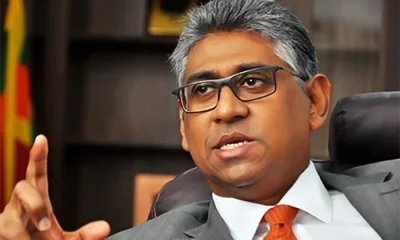
 News3 days ago
News3 days agoBroad support emerges for Faiszer’s sweeping proposals on long- delayed divorce and personal law reforms
-

 News4 days ago
News4 days agoPrivate airline crew member nabbed with contraband gold
-

 News2 days ago
News2 days agoPrez seeks Harsha’s help to address CC’s concerns over appointment of AG
-

 News2 days ago
News2 days agoGovt. exploring possibility of converting EPF benefits into private sector pensions
-

 Latest News20 hours ago
Latest News20 hours agoWarning for deep depression over South-east Bay of Bengal Sea area
-

 Features3 days ago
Features3 days agoEducational reforms under the NPP government
-

 News6 days ago
News6 days agoHealth Minister sends letter of demand for one billion rupees in damages


